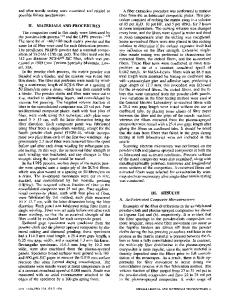In-Situ Synthesis of Intermetallic Matrix Composites
- PDF / 5,669,226 Bytes
- 13 Pages / 420.48 x 639 pts Page_size
- 50 Downloads / 599 Views
IN-SITU SYNTHESIS OF INTERMETALLIC MATRIX COMPOSITES DILIP M. SHAH* AND DONALD L. ANTON** * Pratt & Whitney, 400 Main St., E. Hartford, CT. 06108 "**UnitedTechnologies Research Center, Silver Lane, E. Hartford, CT. 06108 ABSTRACT In pursuing the development of intermetallics as high temperature structural materials, a composite approach is considered necessary for achieving room temperature toughness. If not further qualified, the term "composite" generally implies the application of mechanical processes by which a strong reinforcing phase is dispersed in the matrix, often as aligned continuous fibers. While this approach appears simple and promising in principle, in practice it is limited by the availability of compatible fibers, controlled processing, and microstructural homogeneity and reproducibility. Alternatively, the composite microstructures may be created in-situ either synthetically or naturally. In synthetically derived composites, the desired phases may be deposited layer by layer using such techniques as chemical vapor deposition (CVD), and potentially a variety of lithographic techniques may be employed to control the microstructure. However, such techniques are currently rate limited and not well developed for the large dimensions required for structural composites. In contrast, the in-situ composites, which rely on phase separation by either eutectic solidification or solid state precipitation, are economical and especially well suited for generating naturally compatible ductile phase toughened composites with uniform fine scale microstructures. This paper attempts to classify these approaches in perspective, discuss the benefit of in-situ composites relying on the natural phase separation mechanisms, and review the current activities with emphasis on the concept of ductile phase toughening. INTRODUCTION The need for high temperature materials beyond the current generation of single crystal superalloys for jet propulsion is a given, in spite of the changing economic and political climate [1]. If anything, for the next generation of materials, the emphasis is likely to shift toward greater reliability, durability and low cost. For fulfilling these demanding requirements of high temperature structural materials for dynamic applications, the development potential of refractory intenrmetallics has been explored[2-4]. With the current design philosophy, the relatively low modulus, high thermal conductivity and ductile behavior at high temperatures associated with the metallic characteristics of intermetallics are considered beneficial. The potential for improving the ultimate strength, high temperature creep resistance and oxidation resistance, to a realistic level, has been demonstrated for various refractory intermetallics with ternary additions. The problem at hand is to optimize all these properties for one system with acceptable room temperature toughness - or perhaps ductility. To achieve this goal, several composite approaches are being evaluated. Among these, in-situ synthesis of composites as op
Data Loading...











